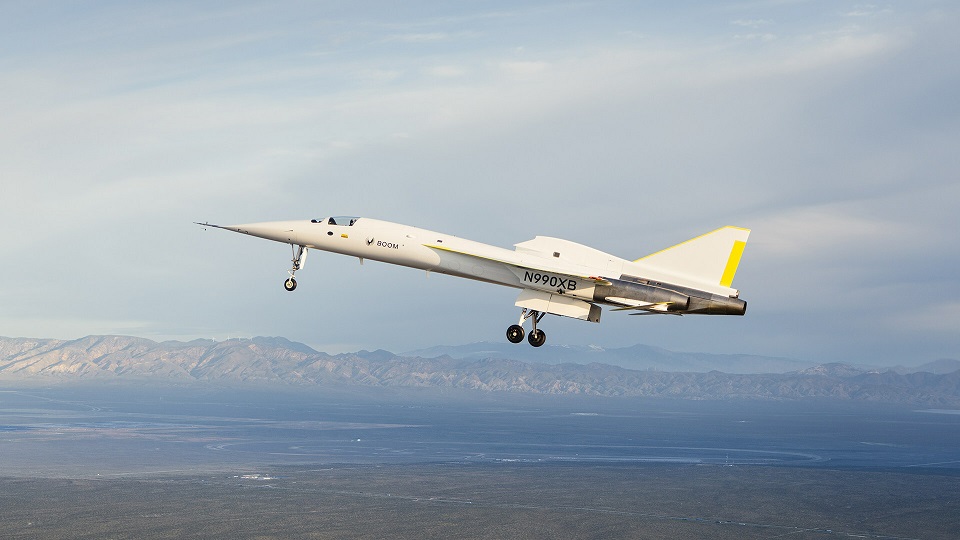Aerospace
Boom Supersonic’s XB-1 Demonstrator Aircraft Completes Successful Test Flight

The world’s first independently developed supersonic jet, the XB-1, successfully completed a flight at the Mojave Air & Space Port in Mojave, California. Boom Supersonic is the business producing the fastest airliner in the world, Overture.
Similar to Overture, XB-1 uses cutting-edge technologies, including as cutting-edge avionics, digitally optimised aerodynamics, carbon fibre composites, and an improved supersonic propulsion system, to enable effective supersonic flight.
Test Pilot Tristan “Geppetto” Brandenburg piloted the T-38 chase aircraft that saw the flight, while boom overture Chief Test Pilot Bill “Doc” Shoemaker piloted the XB-1. Launched from Mojave Air & Space Port, XB-1 flew in the same airspace as several historic first flights, such as Bell X-1, North American X-15, and Lockheed SR-71 Blackbird. The XB-1 achieved all test objectives, including reaching a speed of up to 238 knots (273 mph) at an altitude of 7,120 feet safely.
The inaugural flight of XB-1, which takes place twenty years after Concorde’s retirement, signifies the return of a civil supersonic aircraft to the sky and opens the door for the revival of supersonic travel in general. Overture’s design and development are based on the XB-1 programme, which also fosters a safety-first attitude in engineering and manufacturing. Important developments and technology validated by XB-1 include:
- Augmented reality vision system: Two nose-mounted cameras, digitally augmented with attitude and flight path indications, feed a high resolution pilot display enabling excellent runway visibility. This system enables improved aerodynamic efficiency without the weight and complexity of a movable nose.
- Digitally-optimized aerodynamics: Engineers used computational fluid dynamics simulations to explore thousands of designs for xb 1. The result is an optimized design that combines safe and stable operation at takeoff and landing with efficiency at supersonic speeds.
- Carbon fiber composites: XB-1 is almost entirely made from carbon fiber composite materials, enabling it to realize a sophisticated aerodynamic design in a strong, lightweight structure.
With 130 orders and pre-orders from American Airlines, United Airlines, and Japan Airlines in its order book and a developing worldwide network of Tier 1 suppliers, Overture is moving closer to production as the XB-1 demonstrator makes its first flight. 64–80 people can travel aboard Overture at Mach 1.7, which is roughly twice as fast as current subsonic aircraft. Overture is engineered to operate on up to 100% sustainable aviation fuel (SAF) and is optimised for speed, safety, and sustainability.

Aerospace
Boeing Transfers Rocket Stage to NASA, Paving Way for Human Moon Mission

Boeing has achieved a significant milestone by providing NASA with the second core stage of the Space Launch System (SLS) rocket.
This crucial component, crafted at NASA’s Michoud Assembly Facility (MAF), is set to propel the Artemis II crew into lunar orbit, marking humanity’s return to deep space after a 50-year hiatus.
The monumental Boeing-built rocket stage, the largest element of the Artemis II mission, will embark on a journey aboard the Pegasus barge, traveling 900 miles to NASA’s Kennedy Space Center.
Comparison of two legendary aircraft B777x vs B747 aircraft:Click here
Upon arrival, it will be meticulously integrated with other essential Artemis II components, including the upper stage, solid rocket boosters, and NASA’s Orion spacecraft within the iconic Vehicle Assembly Building. This intricate integration process is a vital step toward the eagerly anticipated Artemis II launch, slated for 2025.
“Boeing-built products helped land humankind on the moon in 1969, and we’re proud to continue that legacy through the Artemis generation,” remarked Dave Dutcher, vice president and program manager for Boeing’s SLS program. “Together, with NASA and our industry partners and suppliers, we are building the world’s most capable rocket and paving the way to deep space through America’s rocket factory in New Orleans.”
NASA, Lockheed Martin Reveal X-59 Quiet Supersonic Aircraft:Click here
The delivery of Core Stage 2 marks a significant achievement in the evolution of the SLS rocket. Towering over 200 feet and powered by four RS-25 engines, this core stage, coupled with two solid-fueled booster rockets, will generate a staggering 8.8 million pounds of thrust. This immense power is crucial to launching Artemis II and future missions into the vast expanse of space.
The SLS rocket stands unparalleled in its capability to transport both crew and substantial cargo to the moon and beyond in a single launch. Its extraordinary capacity will facilitate the delivery of human-rated spacecraft, habitats, and scientific missions to destinations including the moon and Mars, ushering in a new era of space exploration.
-

 Travel1 week ago
Travel1 week agoAir India to Expand US Operations with Three New Routes After a Decade
-

 Travel2 weeks ago
Travel2 weeks agoWhy We Should Avoid These Stamps in a Passport
-

 Airlines1 month ago
Airlines1 month agoInvestigations Reveal Fake Chinese Titanium in Boeing and Airbus Jets
-

 Tech4 weeks ago
Tech4 weeks agoChina’s CATL Plans 1,800-Mile Electric Plane Launch by 2027
-

 Airport3 days ago
Airport3 days agoTop 10 Largest Airports in the World by Size
-

 Aerospace4 weeks ago
Aerospace4 weeks agoChina’s Fighter Jets Turn Wings into Autonomous Drones
-

 Airlines4 days ago
Airlines4 days agoAir India Rolls Out A350s for Delhi-New York JFK and Newark Routes
-

 Defence3 weeks ago
Defence3 weeks agoBoeing Enhances Chinook with New Engines and Block II Upgrades at $96 Million







